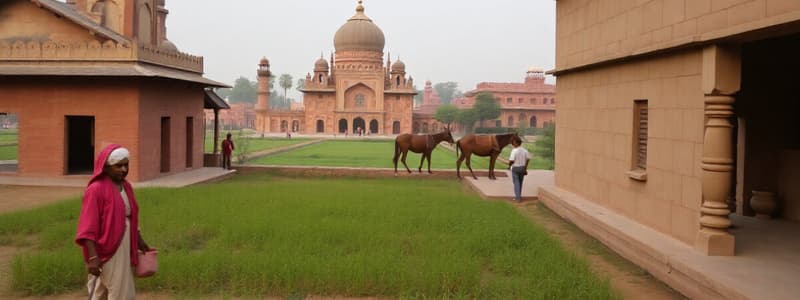Podcast
Questions and Answers
What percentage of India's population lived in villages during the sixteenth and seventeenth centuries?
What percentage of India's population lived in villages during the sixteenth and seventeenth centuries?
- 90%
- 75%
- 50%
- 85% (correct)
Which of the following best describes the relationship between peasants and landed elites in rural society?
Which of the following best describes the relationship between peasants and landed elites in rural society?
- There were relationships of cooperation, competition, and conflict. (correct)
- Landed elites solely exploited peasants without sharing produce.
- They functioned independently with no interaction.
- They were in constant conflict without any cooperation.
What was the primary source of income for the Mughal state during the sixteenth and seventeenth centuries?
What was the primary source of income for the Mughal state during the sixteenth and seventeenth centuries?
- Taxation from agricultural production (correct)
- Revenue from forest products
- Land leasing to peasants
- Trade from the towns
Which of the following roles did agents of the Mughal state NOT have in rural society?
Which of the following roles did agents of the Mughal state NOT have in rural society?
Which of these sources provides significant information about agrarian history in the Mughal era?
Which of these sources provides significant information about agrarian history in the Mughal era?
What is the primary agricultural task performed by peasants throughout the year?
What is the primary agricultural task performed by peasants throughout the year?
What geographical factors impacted agricultural production in rural India?
What geographical factors impacted agricultural production in rural India?
What agro-based goods did peasants contribute to producing?
What agro-based goods did peasants contribute to producing?
What was the central purpose of the Ain regarding Akbar’s empire?
What was the central purpose of the Ain regarding Akbar’s empire?
Which term was most frequently used to denote a peasant in Indo-Persian sources during the Mughal period?
Which term was most frequently used to denote a peasant in Indo-Persian sources during the Mughal period?
What are the two kinds of peasants referred to in seventeenth-century sources?
What are the two kinds of peasants referred to in seventeenth-century sources?
Under what circumstances did people become pahi-kashta?
Under what circumstances did people become pahi-kashta?
What was often a common possession of an average peasant in North India?
What was often a common possession of an average peasant in North India?
How much land was considered affluent for peasants in Gujarat?
How much land was considered affluent for peasants in Gujarat?
What was the principle upon which cultivation was based?
What was the principle upon which cultivation was based?
Which region's records provide useful descriptions of agrarian relations in eastern India?
Which region's records provide useful descriptions of agrarian relations in eastern India?
Flashcards are hidden until you start studying
Study Notes
Agrarian Society in India (16th-17th Century)
- Approximately 85% of India's population lived in villages, highlighting a predominantly rural society.
- Both peasants and landed elites engaged in agricultural production, forming relationships characterized by cooperation, competition, and conflict.
- The Mughal state played a crucial role in rural society, collecting taxes primarily from agricultural production.
Peasants and Agricultural Production
- Villages served as the core units of agricultural society where peasants performed essential tasks like tilling, sowing, and harvesting throughout the year.
- In addition to food crops, peasants also contributed labor to produce agro-based goods such as sugar and oil.
- Varied geographical features, including dry lands and forests, impacted agricultural practices and productivity.
Sources of Agrarian History
- Peasants did not document their own experiences, leading historians to rely on Mughal court chronicles and documents for understanding agrarian life.
- The Ain-i Akbari, authored by Abu’l Fazl, detailed state arrangements for cultivation and revenue collection, reflecting the perspective of the ruling elite.
- The Ain aimed to establish a vision of social harmony under Akbar’s strong governance, downplaying peasant dissent.
Regional Documentation
- Revenue records from regions like Gujarat, Maharashtra, and Rajasthan from the 17th and 18th centuries supplemented the understanding of agrarian relations.
- Accounts from the East India Company provide insights into the dynamics between peasants, zamindars (landowners), and the state, revealing conflicts and peasant expectations.
Terminology and Types of Peasants
- Key terms for peasants in Indo-Persian sources included "raiyat" (singular), "riaya" (plural), "kisan," and "asami."
- Two types of peasants were identified:
- Khud-kashta: Residents of the village cultivating their own lands.
- Pahi-kashta: Non-resident cultivators who worked lands in other villages, often based on contractual agreements.
Economic Conditions and Land Ownership
- Many peasants had minimal assets, often owning only a pair of bullocks and a couple of ploughs.
- Wealth and land ownership varied by region; in Gujarat, six acres marked affluence, whereas five acres represented the upper limit for average farms in Bengal.
- Individual ownership governed agricultural practices, indicating a personal investment in land cultivation.
Studying That Suits You
Use AI to generate personalized quizzes and flashcards to suit your learning preferences.



